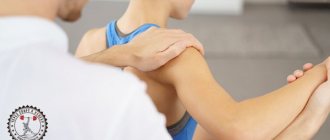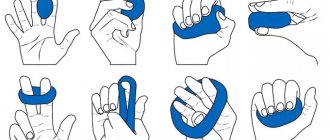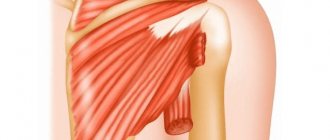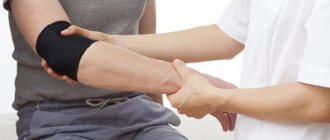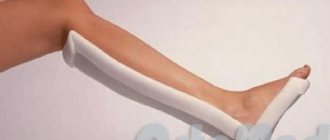Long process of recovery of the elbow joint after injury
Any bone fracture requires treatment with complete rest. To do this, the injured limb is immobilized: it is “placed” in a plaster cast. How long the patient will have to walk with a cast on his arm will be determined by the doctor after an x-ray examination. If the fracture is complex and the bone fragments are displaced, then surgery will be performed before applying the plaster. In this case, immobilization will last longer, as will the recovery period.
Gymnastics for the elbow joint is necessary at all stages of the rehabilitation period. It begins 2-3 days after applying a plaster cast.
The average recovery period for an elbow fracture is 3-4 months. However, this period can increase depending on the severity of the injury and reach six months. To make rehabilitation faster and more effective, it is carried out in 3 stages, selecting specific exercises for each of them.
- The first stage is the period when a plaster cast is applied to the fractured joint. The training involves the shoulder girdle and fingers. Since all parts of the upper limb are a single “chain” connected by ligaments, tendons and muscles, such exercises will help develop joints even at the stage of immobilization. Physical exercises are combined with breathing exercises.
- The second stage is the period immediately after the removal of the plaster. This time is devoted to developing “stagnant” ligaments and muscles. Classes are combined with taking warm baths. Shows how to perform exercises in a swimming pool.
- At the third stage, the goal of training is to completely restore the functionality of muscle tissue, ligaments and tendons. Exercises to develop the elbow joint are combined with physiotherapeutic procedures, massage, and other physical activity.
Training at each stage is carried out 2-3 times a day every day, and each exercise is repeated at least 5 times. Severe pain and discomfort are a reason to stop exercising or reduce the load. During the rehabilitation period, you should not lift heavy objects with your injured arm, do presses or pull-ups.
If you incorrectly calculate the load, the following complications may occur:
- Swelling of the injured joint;
- Pain that radiates to the shoulder;
- Accumulation of calcium salts in muscle tissue;
- Reflex contraction of muscle tissue;
- “Growth” of bone in the elbow joint.
If the patient follows all the recommendations of the attending physician, these complications will be avoided and the recovery period will be significantly reduced.
Why do my elbows feel pain after exercise?
The reason is simple - certain physiological changes occur in the joint, which appear when the elbow joint is heavily loaded. For example, after strength exercises in the gym, lifting heavy bags, moving furniture. When your elbows hurt from physical activity, this may indicate:
- pinched nerve;
- destruction of cartilage tissue (osteoarthrosis);
- bursitis;
- chondrocalcinosis;
- fasciitis;
- tendinitis;
- epicondylitis;
- osteochondrosis.
Problems with the elbow joints can be divided into three main groups. The first includes pathological changes in bone, cartilage and muscle tissue, the second includes malignant and benign neoplasms, and the third includes inflammatory processes.
The reason why your elbow hurts may be due to an old injury that initially did not cause problems, but eventually led to complications. If the unpleasant sensations are repeated, and the elbow hurts in the joint every time with increased load, you should not self-medicate. A light massage can aggravate the situation if the diagnosis is incorrect. You should seek medical help as soon as possible and undergo a comprehensive examination. Based on the results obtained, the specialist will make a decision on how to solve the problem.
Massage and exercise therapy course
The intensity of the activity increases as the broken bone heals. The physical therapy complex is selected individually at each stage. The same rule applies to massage.
It is not recommended to use it at the first stage of treatment and recovery. However, some doctors prescribe massage in the shoulder girdle, provided that the fracture is not displaced. Properly performed massage sessions help improve blood flow and strengthen ligaments and muscles. In this case, independent appointments are unacceptable!
Let's present examples of sets of exercises for the elbow joint at each stage of recovery.
Exercises to help develop the elbow at stage 1
While the arm is in a cast, training is limited to performing the following exercises:
- Clenching your fingers into a fist and unclenching it;
- Spreading the fingers to the sides and bringing them together;
- Circular movements with each finger alternately clockwise and back;
- Kneading plasticine with fingers;
- Rolling balls with your fingers.
When performing exercises, remember that the injured elbow, enclosed in a cast, should not participate in the training process.
Exercises to help develop the elbow at stage 2
After removing the plaster cast, the arm becomes swollen, making it difficult to perform exercises. To make the task easier, the patient needs to lie on his back and place his hand above his head for 20-30 seconds. This time is enough for the swelling to subside a little, and with it the discomfort of doing the exercises goes away. Also, to eliminate swelling and discomfort, a special bandage is used, which will help limit the range of movements.
Let us list several exercises, the implementation of which during this period of rehabilitation will not harm, but will help all patients.
- Sit down, put your hands on the table. Imitate playing the piano by slowly “drumming” your fingers on the table.
- Throw a tennis ball so that it hits the wall. Try to catch the ball that bounces off the wall with your hand.
- Bring your palms together and lower them down, then return them to the starting position.
- Stretch the anti-stress ball regularly.
- Lock your fingers together. Raise and lower your clasped hands above your head.
- Hold 2-3 balls in your palm and rotate them intensively, rolling them with your fingers.
- Place your hand on the table. Slowly, controlling your breathing, try to straighten your elbow. Remember that sudden movements aimed at “working” the elbow joint are not yet permissible.
- Continue clenching and unclenching your fingers regularly.
Exercises to help develop the elbow at stage 3
The last period of rehabilitation also takes place under the supervision of a doctor. At this stage, additional treatment in the form of physiotherapy is most often prescribed. The exercises become more complicated, they can be performed with a load in the form of dumbbells of 1 kg each.
- Interlace your fingers into a lock. Imagine that you need to cast a fishing rod as far as possible. Repeat the movements, changing the direction of the fishing rod, moving your hands to the right and then to the left.
- Place your hands behind your back so that you can clasp your palms together.
- Repeat the previous exercise. With your hands clasped behind your back, stand on your toes, stretching your body up and your arms down.
- Play "cars". While rolling a child's toy, the flexion and extension functions of the elbow joint are developed.
- Place your hands at chest level. Interlace your fingers. “Take” the lock alternately to the right shoulder, then to the left, to the head, to the stomach.
Once these exercises become easy for you, start using dumbbells.
Physiotherapy
How to develop the elbow after a fracture through physiotherapeutic manipulations is determined by the doctor in accordance with the therapeutic plan. Their use will help to significantly shorten the period of rehabilitation therapy. However, to achieve a positive result, it is necessary to strictly follow the instructions of specialists:
- Treatment should correspond to the rehabilitation stage. During the recovery process, physical therapy manipulations will change to ensure better healing. Based on the actual condition of the person, the specialist selects the type of physical therapy and its duration.
- As the patient's condition improves, physical therapy procedures should change. An X-ray examination is a mandatory step prior to a new medical prescription. It helps track progress in bone tissue restoration. The traumatologist makes changes to the therapeutic regimen based on the results obtained. He can adjust the type of procedures, as well as the frequency, intensity and duration of their implementation.
- The prescription of a particular physiotherapeutic procedure is made based on a number of factors, including the age and general health of the patient, the presence of allergic reactions and contraindications.
- The principle of regularity of physiotherapy procedures is key during the rehabilitation period. Because an elbow fracture, the recovery of which must take place under the supervision of a doctor, is complex. If the patient is aiming for a positive outcome, he needs to undergo a full course of procedures in accordance with the prescriptions of the attending physician.
- A combination of various physiotherapeutic manipulations. They can be performed either simultaneously or at set time intervals.
Physiotherapy includes the following procedures:
- Magnetic therapy, which stimulates the formation of bone calluses, fights inflammation and eliminates pain. You can start magnetic therapy on the third day after applying the plaster after preliminary consultation with your doctor.
- Paraffin treatment can be used only after swelling has subsided. It helps improve blood circulation in the affected area and has an antiseptic effect.
- Darsonvalization, carried out using high-frequency alternating current and minimal voltage. Stimulates faster bone fusion, eliminates pain and tones the walls of blood vessels.
- UHF, based on the use of ultra-high frequencies of a magnetic field. Accelerates the regeneration of damaged skin, relieves swelling, improves blood flow and relieves inflammatory processes.
- Ultraviolet therapy. During its implementation, penetrating electromagnetic rays help eliminate swelling, inflammation and spasms.
- Electrophoresis is based on the delivery of a drug to the affected areas through electrical impulses. Has anti-inflammatory and analgesic effects.
Why do you need to develop a joint?
Rehabilitation exercises should be started as early as possible. Such “emergency” measures are related to the fact that when a limb is immobilized, the nutrition of its tissues, vessels and muscles is disrupted. Poor blood circulation in the area of the elbow joint will lead to partial or complete atrophy of muscles and ligaments, loss of their elasticity. The tendons shorten and become thinner. The reduced size of ligaments and tendons negatively affects the functioning of the joint: they cannot “protect” it from sprains. All this causes partial or complete immobilization of the hand.
How to alleviate the condition before starting treatment
Diagnosis may take several weeks, during which time the patient will experience pain. You can minimize discomfort by reducing physical activity - you will have to temporarily give up sports and any activities that cause pain symptoms. Ensuring complete immobility of the elbow at home is quite problematic, but until the end of the examination it is still worth minimizing any movements of the joint.
What to do if your elbow hurts very badly during exercise? First, you should stop the pain attack using anabolic steroids orally. Ointments with an analgesic effect, the effect of which is often based on warming up the skin, dilating blood vessels and increasing blood circulation in the problem area, are best postponed until the cause of the discomfort is clearly established. If the arm hurts in the elbow when lifting weights due to a malignant tumor, warming ointment can aggravate the situation and provoke the development of metastases.
What is prohibited during the rehabilitation period
The most common mistake patients make after an elbow fracture is choosing rehabilitation exercises on their own. No matter how simple the exercises may seem, the doctor must select them taking into account the characteristics of the injury. An incorrectly performed or selected exercise therapy complex can cause more harm than its absence.
It is also dangerous to massage a damaged elbow joint on your own. A particularly unfavorable outcome awaits the patient if you massage the injured arm immediately after removing the plaster cast. Unprofessional actions will lead to joint displacement, the formation of a bone spur or muscle rupture.
Another common mistake is placing stress on the injured arm immediately after removing the cast. Do not assume that the end of immobilization means a complete recovery. This is only the first part of the treatment. Only after systematic and consistent development of the joint can you gradually begin dosed loading. Incorrectly selected physical activity will lead to swelling, pain and deformation of the joint tissue.
Follow the doctor’s recommendations, and then the rehabilitation period will pass quickly and without complications.
Who's at risk
Elbow pain and arthrosis of the elbow joint itself often results from injuries, fractures, bruises, and sprains. Most often, such complaints come from those who subject their arms to the same type of stress - constantly bending and straightening their elbows. Therefore, representatives of the following groups are advised to be especially vigilant:
- athletes (especially tennis players, basketball players, volleyball players, fencers);
- violinists;
- builders - masons and carpenters;
- massage therapists;
- hairdressers;
- summer residents;
- housewives doing various housework.
Elbow arthrosis often occurs in surgeons

